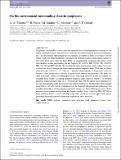On the environment surrounding close-in exoplanets
Abstract
Exoplanets in extremely close-in orbits are immersed in a local interplanetary medium (i.e. the stellar wind) much denser than the local conditions encountered around the Solar system planets. The environment surrounding these exoplanets also differs in terms of dynamics (slower stellar winds, but higher Keplerian velocities) and ambient magnetic fields (likely higher for host stars more active than the Sun). Here, we quantitatively investigate the nature of the interplanetary media surrounding the hot Jupiters HD 46375b, HD 73256b, HD 102195b, HD 130322b and HD 179949b. We simulate the three-dimensional winds of their host stars, in which we directly incorporate their observed surface magnetic fields. With that, we derive mass-loss rates (1.9–8.0 × 10−13 M⊙ yr−1) and the wind properties at the position of the hot Jupiters’ orbits (temperature, velocity, magnetic field intensity and pressure). We show that these exoplanets’ orbits are supermagnetosonic, indicating that bow shocks are formed surrounding these planets. Assuming planetary magnetic fields similar to Jupiter's, we estimate planetary magnetospheric sizes of 4.1–5.6 planetary radii. We also derive the exoplanetary radio emission released in the dissipation of the stellar wind energy. We find radio fluxes ranging from 0.02 to 0.13 mJy, which are challenging to be observed with present-day technology, but could be detectable with future higher sensitivity arrays (e.g. Square Kilometre Array). Radio emission from systems having closer hot Jupiters, such as from τ Boo b or HD 189733b, or from nearby planetary systems orbiting young stars, are likely to have higher radio fluxes, presenting better prospects for detecting exoplanetary radio emission.
Citation
Vidotto , A , Fares , R , Jardine , M M , Moutou , C & Donati , J-F 2015 , ' On the environment surrounding close-in exoplanets ' , Monthly Notices of the Royal Astronomical Society , vol. 449 , no. 4 , pp. 4117-4130 . https://doi.org/10.1093/mnras/stv618
Publication
Monthly Notices of the Royal Astronomical Society
Status
Peer reviewed
ISSN
0035-8711Type
Journal article
Description
AAV acknowledges support from the Swiss National Science Foundation through an Ambizione Fellowship. RF acknowledges support from a STFC grant. Date of Acceptance: 17/03/2015Collections
Items in the St Andrews Research Repository are protected by copyright, with all rights reserved, unless otherwise indicated.

